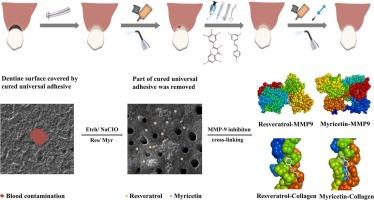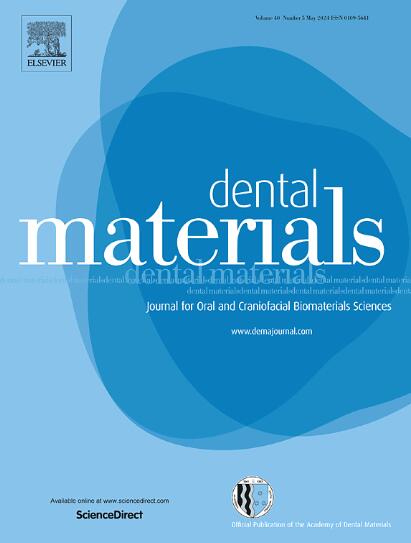A comparison of different cleaning approaches for blood contamination after curing universal adhesives on the dentine surface
IF 4.6
1区 医学
Q1 DENTISTRY, ORAL SURGERY & MEDICINE
引用次数: 0
Abstract
Objective
This study compared the effectiveness of various cleaning approaches, including spray rinsing, repreparing with diamond burs, and using phosphoric acid or sodium hypochlorite alone or with polyphenols (resveratrol or myricetin), in removing blood contamination from the dentine after adhesive light-curing.
Methods
The contact angles of the treated surfaces were measured and scanning electron microscopy/ energy dispersive X-ray spectroscopy observation was performed. The bond strength and nanoleakage were assessed, and in situ zymography was performed before and after aging. Interactions between matrix metalloproteinase (MMP)−9 and polyphenols were evaluated using molecular dynamics and rhMMP-9 inhibition analyses. The destruction of sodium hypochlorite on collagen and the resistance of polyphenols-treated dentine collagen to enzymolysis were evaluated using the hydroxyproline (HYP) assay. The effect of polyphenols on dentine collagen crosslinking was assessed by Fourier Transform Infrared Spectroscopy.
Results
The repreparation group had the lowest contact angle compared to the other groups. The spray rinsing group had the lowest bond strength and highest amounts of nanoleakage. Cleaning with phosphoric acid or sodium hypochlorite alone removed the blood contaminants and parts of the adhesive; moreover, applying polyphenols further improved the bond strength and decreased nanoleakage and MMP activity after aging. Both polyphenols inhibited rhMMP-9 activity and promoted collagen crosslinking. Sodium hypochlorite showed the maximum HYP release when used alone, which was decreased after adding polyphenols.
Significance
Phosphoric acid or sodium hypochlorite cleaning can remove blood contamination from the dentine surface after adhesive curing, and the addition of polyphenols can improve the durability of dentine bonding.

牙本质表面通用粘合剂固化后不同血液污染清洁方法的比较。
目的:本研究比较了各种清洁方法(包括喷雾冲洗、用金刚石车针重新修整、单独使用磷酸或次氯酸钠或与多酚类物质(白藜芦醇或杨梅素)一起使用)在去除粘接剂光固化后牙本质上的血液污染方面的效果:方法:测量经处理表面的接触角,并进行扫描电子显微镜/能量色散 X 射线光谱观察。评估了粘接强度和纳米渗漏,并在老化前后进行了原位酶谱分析。使用分子动力学和 rhMMP-9 抑制分析评估了基质金属蛋白酶(MMP)-9 和多酚之间的相互作用。使用羟脯氨酸(HYP)测定法评估了次氯酸钠对胶原蛋白的破坏作用以及经多酚处理的牙本质胶原蛋白对酶解的抗性。傅立叶变换红外光谱法评估了多酚对牙本质胶原交联的影响:结果:与其他组相比,再制备组的接触角最小。喷淋冲洗组的粘接强度最低,纳米渗漏量最高。仅用磷酸或次氯酸钠清洗可去除血液污染物和部分粘合剂;此外,使用多酚可进一步提高老化后的粘合强度,减少纳米渗漏和 MMP 活性。两种多酚都能抑制 rhMMP-9 的活性,促进胶原交联。单独使用次氯酸钠时,HYP 释放量最大,添加多酚后释放量下降:意义:磷酸或次氯酸钠清洗可以清除粘接剂固化后牙本质表面的血污,而添加多酚可以提高牙本质粘接的耐久性。
本文章由计算机程序翻译,如有差异,请以英文原文为准。
求助全文
约1分钟内获得全文
求助全文
来源期刊

Dental Materials
工程技术-材料科学:生物材料
CiteScore
9.80
自引率
10.00%
发文量
290
审稿时长
67 days
期刊介绍:
Dental Materials publishes original research, review articles, and short communications.
Academy of Dental Materials members click here to register for free access to Dental Materials online.
The principal aim of Dental Materials is to promote rapid communication of scientific information between academia, industry, and the dental practitioner. Original Manuscripts on clinical and laboratory research of basic and applied character which focus on the properties or performance of dental materials or the reaction of host tissues to materials are given priority publication. Other acceptable topics include application technology in clinical dentistry and dental laboratory technology.
Comprehensive reviews and editorial commentaries on pertinent subjects will be considered.
 求助内容:
求助内容: 应助结果提醒方式:
应助结果提醒方式:


